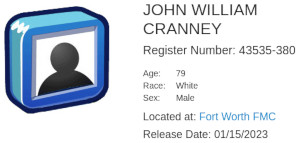
He remained with the company until 2012. That same year Cranney was charged with running a $10.4 million dollar Ponzi scheme.
I came across Cranney’s story as part of my research for a Shaklee review.
Before we continue, I want to stress that Shaklee corporate were never implicated in Cranney’s Ponzi scheme, at least not publicly.
I felt that due to that, it wasn’t appropriate to include the details of Cranney’s Ponzi scheme in our yet to be published review.
So instead I’ve published Cranney’s story below, as I think it still makes for an interesting enough read.

As late as 2010, Cranney was still winning awards at Shaklee. That year he was recognized for generating the largest downline growth both vertically and horizontally.
Estimates peg Cranney’s personally recruited Shaklee distributors at over 50,000. By his own admission, Cranney was “likely” among Shaklee’s top twenty company earners.
Wind things back to 2001. Despite seemingly making good money in Shaklee, Cranney began soliciting investment for a “retirement plan”.
To carry out his scheme, Cranney created shell companies that he named specifically to sound like investment funds.
He also set up a sham Employee Stock Ownership Plan to convince victims to transfer their IRA and 401k retirement funds to him.
Cranney’s investors are believed to mostly be elderly and fellow Shaklee distributors.
A handful of people received payments; others never asked for the interest, simply trusting that Cranney was keeping track of their money.
Cranney ran his investment scheme for over a decade. In 2012 it collapsed, prompting an investigation by the Massachusetts Securities Division.
A fraud cease and desist was issued by the Securities Division in July.
This was followed up by criminal charges filed by the DOJ.
In the years leading up to his trial, Cranney revealed Shaklee cut him off on or around April 2012.
At the time he claimed he was earning “about $45,000 a month”. Income he stated he needed to “repay his creditors”.
When pressed on where the $12 million he collected went,
Cranney described moving money among his various accounts and then using it to pay expenses incurred “in the normal course of business,’’ such as travel, food, and Shaklee meetings.
Cranney, gray-haired and wearing a dark pin-striped suit, pushed his wife, Nevena, up to the hearing table in a wheelchair.
He repeatedly blamed his financial woes on having been consumed with his wife’s care since 2007.
It wasn’t until 2018 that Cranney was found guilty at trial. The trial lasted two-weeks and saw Cranney convicted of
three counts of wire fraud, 12 counts of mail fraud and three counts of money laundering.
The scope of Cranney’s Ponzi scheme was reduced to “over $6 million” stolen from fifteen investors.
In August 2018 Cranney was sentenced to five years in prison plus three years of supervised release. He was also ordered to pay back $5.58 million in restitution.

What caught my attention was Cranney’s position within Shaklee, his targeting of Shaklee distributors and Shaklee seemingly not knowing anything about what he was up to – at least officially.
MLM circles are typically tight-knit, even more so at the top. Surely someone knew what was going on?
Granted it’s not up to MLM company’s to police what their distributors are up to outside of the company – but here it seems difficult to overlook how Shaklee fit into Cranney’s scheme.
For starters Cranney stated some of the money he collected went into “Shaklee meetings”. These don’t happen at the top level without corporate’s knowledge.
Then there was Cranney’s quip about his income and needing it to pay back his creditors;
Cranney predicted that if he could get back to work, “I’ll make $10 million probably in the next 10 years.”
Cranney’s scheme came unraveled, as all Ponzi schemes do, because he was unable to pay his investors.
At the time he was receiving $45,000 a month from Shaklee. I think it’s a given that, at least for some period of time prior to the collapse, Shaklee money was being used to pay some of Cranney’s investors.
Not something Shaklee corporate may have been aware of, but it demonstrates money was flowing both in and out of Shaklee from Cranney’s Ponzi.
I guess what I’m finding it hard to believe is nobody Cranney had solicited ever mentioned their investment to anyone else in Shaklee. Remember, this scam went on for eleven years.
Of course in hindsight these questions and thoughts are purely academic. To what extent anyone in Shaklee corporate was aware of Cranney’s actions we’ll never know.
Considering the lengthy investigation and opportunity for Cranney to implicate anyone else though(he didn’t), ultimately I have to give Shaklee corporate the benefit of the doubt.
Doesn’t mean what happened wasn’t mind-boggling to examine in retrospect though.
I expect to publish BehindMLM’s Shaklee review later this week. I’ll leave an update link below when we do.
For the record other than a mention in the introduction, Cranney’s Ponzi scheme won’t have any bearing on the review itself.
Update 16th August 2020 – BehindMLM’s Shaklee review went live earlier today.